Star Wars is one of the most popular sci-fi adventures of all time. Whether you love the classic stories of Luke, Leia, and Han, the Prequels focusing on Obi-Wan and Anakin, or the newer tales of Rey and Kylo Ren, there’s something for you.
Since Star Wars is so recognized, you might not be surprised to hear that many different variations of Star Wars Monopoly are available today.
For this Star Wars Monopoly guide, I’ve chosen to focus on the variation I actually own – the Star Wars Saga edition. Check it out on Amazon here (although I notice that the price has risen somewhat in the years since I bought it! Second-hand versions might be a better bet!).
Right then. Let’s get into it.
Before You Begin
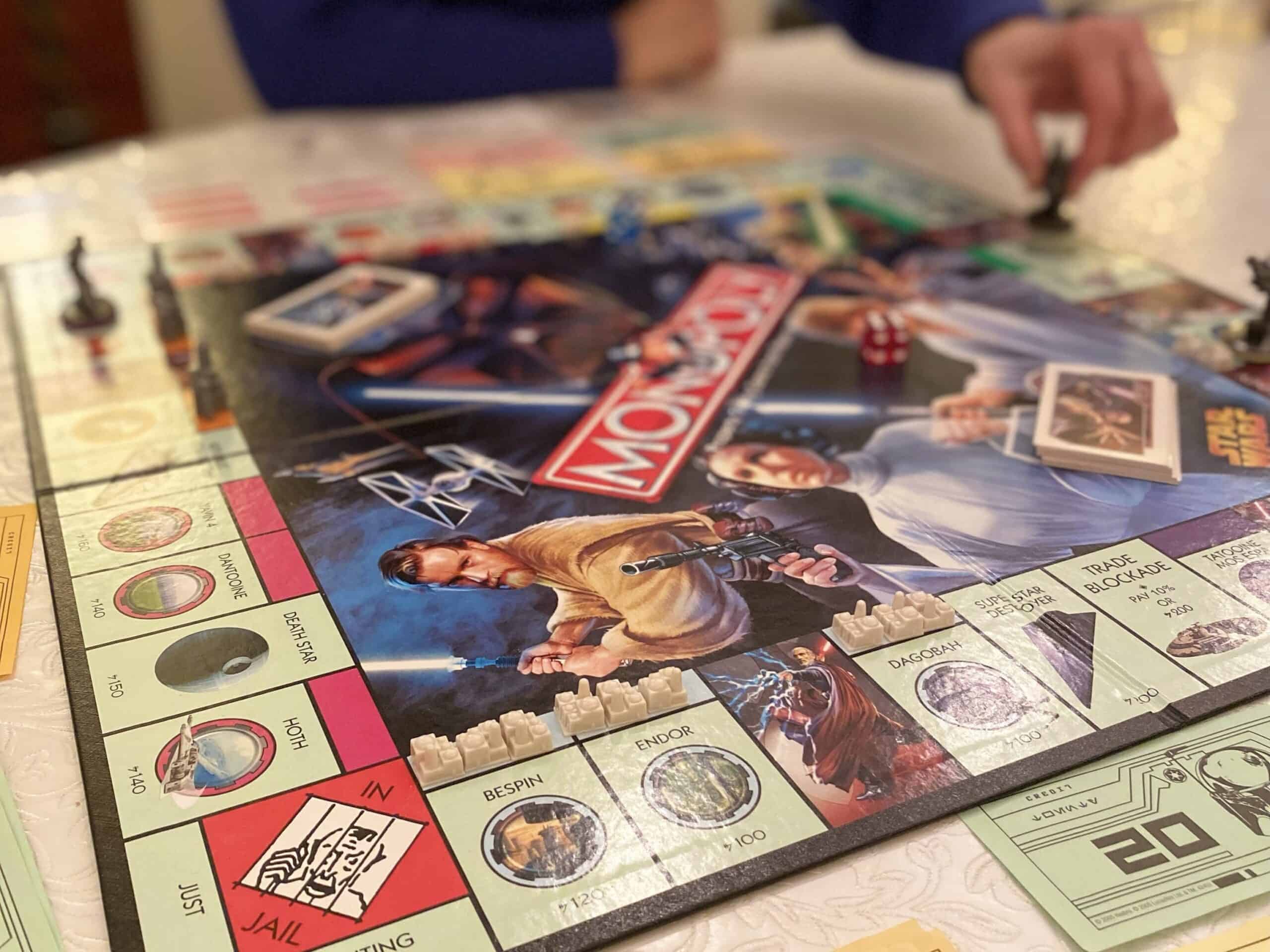
Before we start talking about Star Wars Monopoly, you won’t be surprised to hear that the general rules are basically exactly the same as the standard game. While certain aspects get renamed and, of course, the tokens are based on characters from the galaxy far, far away, the overall game is pretty much no different. Star Wars Saga Edition Monopoly, then, isn’t about a new board game. Instead, it’s for Star Wars fans – through and through. It takes an existing classic and puts a twist on it to appeal to a different fan base.
As a Star Wars fan myself, I love this. It’s a simple concept but makes the playing process that much more enjoyable for me.
Overall, I’d say that Star Wars Monopoly – no matter which version you play – is specifically for Star Wars fans rather than Monopoly fans.
How to Play
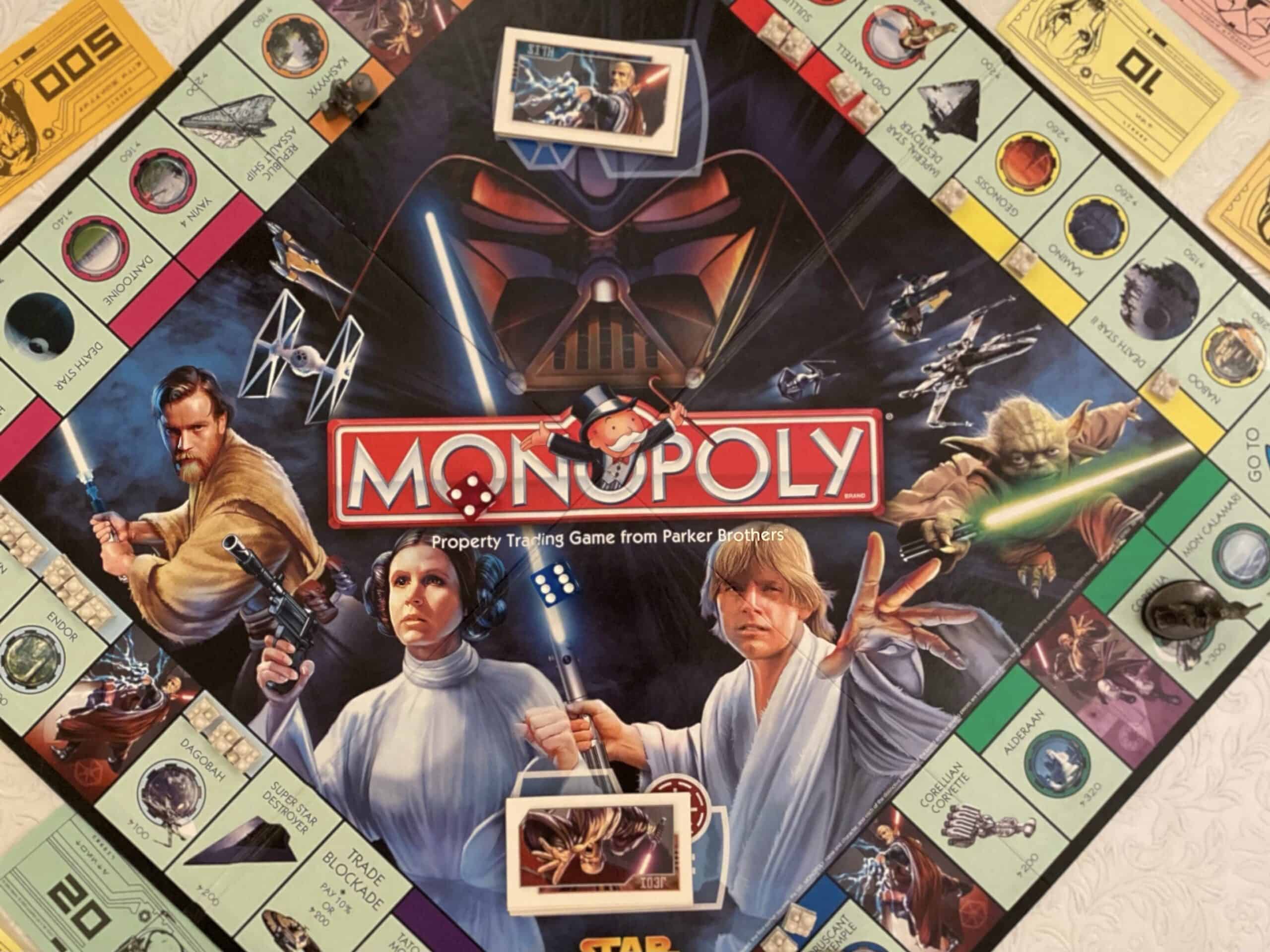
I won’t spend too long explaining how to play – that’s been covered in great detail in other articles on this site. As I mentioned in the introduction, if you know how to play standard Monopoly, you can play a Star Wars version.
For this section, I’ll describe how to play the version I own: the Star Wars Saga Edition. This edition contains a few unique rules to set it apart from other games (see below). There are, naturally, many different variations, which I’ll discuss in more detail later on.
Setting the Board up
Released by Hasbro in 2005, this officially licensed Star Wars product celebrates the original six films in all their glory.
The properties around the edge of the board showcase some of the most well-known locations from Episodes 1 to 6. They include Dagobah, Yavin IV, Kashyyyk, Endor, Hoth, Mustafar, and many more. The lowest (brown) and highest (dark blue) value sets are Tatooine (Mos Espa and Mos Eisley) and Coruscant (Jedi Temple and Senate), in keeping with the general aesthetics of the trilogies. Capital Ships replace the Railroads, while the Utilities become Death Star and Death Star II. Finally, the Income Tax is replaced by Trade Blockade (think back to The Phantom Menace), and the Luxury Tax becomes Bounty.
As usual, place the Chance and Community Chest cards in the middle – except, in this version, they’re simply named Sith and Jedi cards, respectively. Instead of houses and hotels, you’ll be placing settlements and cities. Star Wars credits replace the usual dollars or pounds.
When you start, select from one of eight tokens (four from the Light Side and four from the Dark) and place your chosen character on Go:
- Yoda
- Obi-Wan Kenobi
- Luke Skywalker
- Leia Organa
- Darth Vader
- Emperor Sidious
- Darth Maul
- Darth Vader
These are alluded to by the two dice – one red (Dark Side) and one blue (Light Side). Roll these dice to determine who will be the Banker (highest wins). (Alternatively, pick the most trustworthy person to avoid any fallings out.)
Each player receives 1,500 credits to start, as follows:
- 2x 500
- 2x 100
- 2x 50
- 6x 20
- 5x 10
- 5x 5
- 5x 1
How to Play Star Wars Saga Edition Monopoly
The Banker goes first. In the usual fashion, they roll the two dice and move the respective number of squares. When landing on an unowned property, the player can either purchase it or put it up for auction among the other players. If you land on the Trade Blockade or Bounty squares, you should pay the Bank. Equally, ending up on a Jedi or Sith square means taking one of the cards from the middle, reading it aloud (we know who you are…!), and following the instructions.
Once you have a complete set of colors, you can start placing settlements leading up to a city.
Collect 200 credits every time you pass Go.
When you land on someone else’s property, you must pay the rent (unless it’s currently mortgaged) using your available cash. If you don’t have sufficient credits, you’ll need to mortgage properties to the Bank for half their value. You can’t charge anyone rent for mortgaged properties or build on them until you pay the full price to unmortgage them.
If you can’t pay the rent and run out of properties to mortgage, you are declared bankrupt and out of the game. You can now sit fuming in the corner while your so-called friends continue playing for another hour or two. Oh well, at least the pewter tokens look really cool.
Sound familiar? Thought so. The basic rules of the Star Wars Saga Edition are basically precisely the same as any other version of Monopoly. There are, however, some unique rules around rolling doubles.
Rolling a Double (Unique Star Wars Saga Edition Rules)
In Monopoly: Star Wars Saga Edition, rolling a double is a potential game-changer. In standard Monopoly, a double means you have to roll again. While you can choose to do this, you could instead opt to “use the Force”. What you can do depends on the number rolled.
- Double 1s – “Jump to Hyperspace” – transport yourself (by “Advancing”) anywhere on the board.
- Double 2s – “Jedi Mind Trick” – collect 200 credits from the Bank.
- Double 3s – “Jedi Mind Trick” – collect 50 credits from each player.
- Double 4s – take a Jedi card from the center.
- Double 5s – take a Sith card from the center.
- Double 6s – “Attack” – challenge another player for a property they own (that isn’t part of a set). Both players roll a die. The highest number wins the challenge.
These doubles become more valuable the further you get into the game. For example, a double 1 could mean you jump past an ominous row of cities just lurking, ready to steal your hard-earned credits. Double 2s or 3s could provide a settlement or two for your sets, while Double 6s are just mean (although they do help the game progress in an area that standard Monopoly is known to struggle!). They’re even good if you don’t want to have to roll again on this turn.
You could, of course, simply choose to not play with these rules. However, I enjoy it. In my opinion, it actually improves on the classic game.
Tips to Know in Advance

Before you start playing, the only thing to really make sure you’re aware of is the unique Force power double rolls. Everything else is almost exactly the same as standard Monopoly in all but name. Of course, it’s pure chance that you roll a double (1 in 6, as you may know) – and even then, you have no control over which double (1/36 for each number). It’s simply a case of if you happen to roll a double knowing what to do with it.
Other than that, here are a few standard Monopoly strategies and tips you can apply to the Star Wars Saga Edition:
- Credits (cash) don’t win Monopoly. You need assets (properties). Since the only way to get these is through the luck of the roll, you should buy as much as you possibly can – especially at the start when other players’ rents are unlikely to do much damage to your financial situation.
- Don’t exhaust your credits – I always try to keep enough money on hand to pay for the two highest rents on the board. There’s very little to worry about until those third settlements go down. At this point – provided I have settlements or cities of my own – I switch to a higher risk, keeping enough credits to ensure I can pay off the highest rent only. Saving that much in cash would no longer be feasible towards the end of the game.
- The best sets to focus on are the oranges (Utapau, Mustafar, and Kashyyyk) and the yellows (Naboo, Kamino, Geonosis). Here, settlements and cities cost the same amount as previous sets (pinks and reds) but provide more income. Overall, I’d suggest the oranges are the best since they’re situated exactly where someone leaving Jail is statistically likely to land. They’re also cheap, providing a good return on your investment.
- The worst set in Monopoly is, unsurprisingly, the browns (Tatooine) – the first two properties after Go. Some people like to collect them since they’re a low-risk investment. However, even with a city on, they won’t fetch you much, and if you happen to draw a settlement tax Jedi or Sith card, you’ll probably lose much of your money anyway. As the lowest value set on the board, they hold virtually no trading value and are worth next to nothing to mortgage. I see them as more of a liability than anything else. If you happen to land on one, it might be worth buying, but only so you can sell it off for more value later in the game.
- Capital Ships are a great way to make some money. Having all four will statistically provide approximately the same income as owning both orange and red sets, with about two houses on the four properties nearest to Free Parking. They’re also the most likely to recoup your initial investment fastest – above all the other properties on the board. Not bad.
- On standard properties, build as quickly as you can. The faster you can make money… well, the faster you’ll make more of it!
- If you agree that you can still collect rent while in Jail, just stay there. Don’t fear that man with the whistle! In fact, give him a symbolic hug or something. When you’re stuck “rotting in Jail”, it’s risk-free income, aside from the 1/6 chance of a double when you take your turn. 50 credits or a get-out-of-jail-free card is a small price to pay in exchange for everyone landing on your sets for three turns.
- Please trade. Yes, I know, trading almost always has an obvious winner and an obvious loser. But there are ways to make it work. If nobody trades, the game will just keep on going forever, and it’s annoying. In the same vein, if you genuinely go bankrupt, don’t start making deals and taking loans with other players. The game will simply never end, and there’s not enough cash in it to support these types of things. If you lose, either do so graciously or storm out the room, but do leave the game. There’s no sense in delaying the inevitable indefinitely, and nobody wants to play a stalemate game for hours.
Overall Monopoly: Star Wars Saga Edition Conclusion
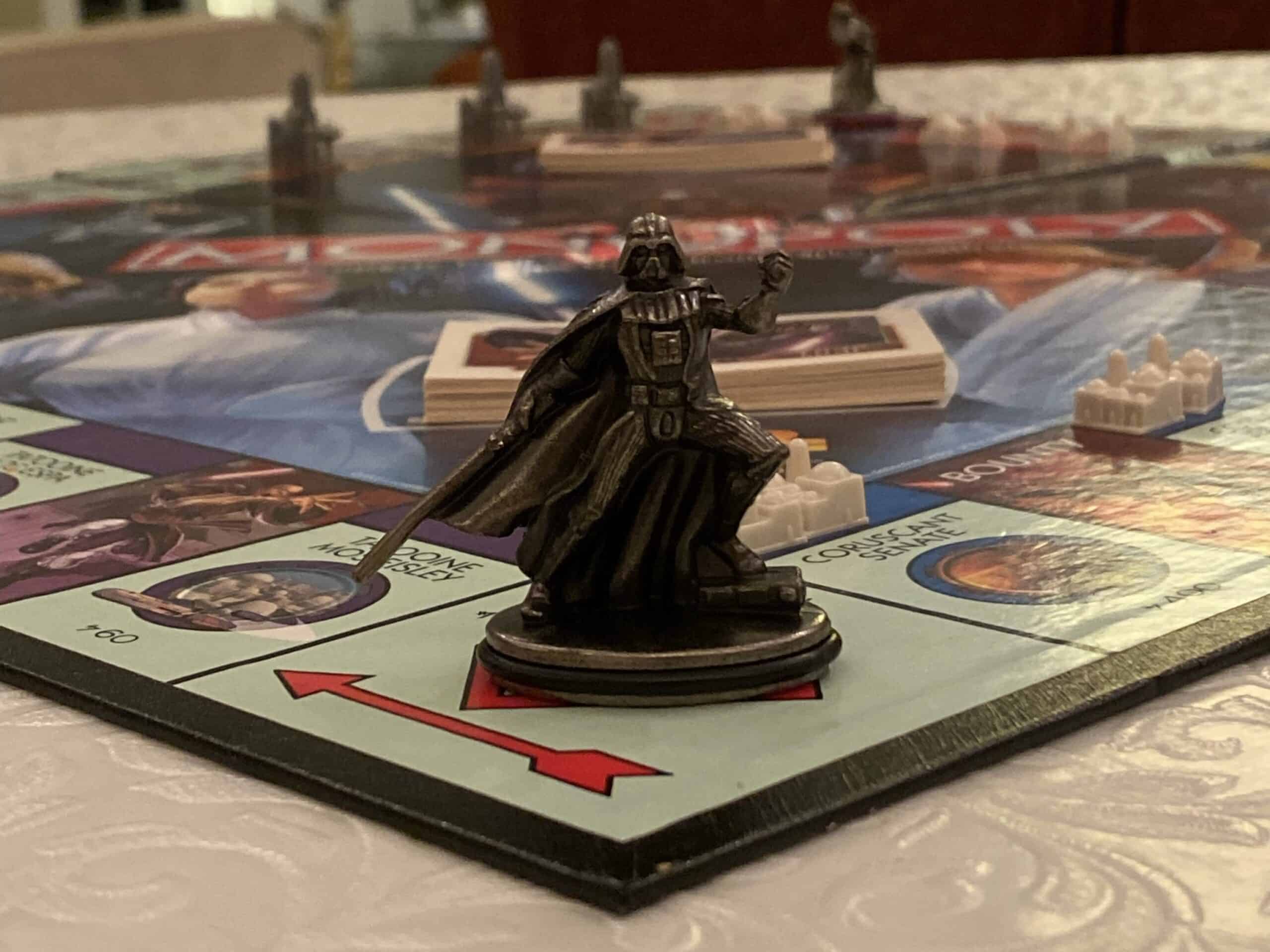
I side with the majority here. I enjoy Star Wars Monopoly for its theme, additional rules, and nicely crafted pewter tokens. However, Monopoly, in general, isn’t my go-to game since the franchise is mainly based on luck and who can be bothered to play the longest.
I’ve been talking about the Monopoly: Star Wars Saga Edition released in 2005. I’ve enjoyed playing this game, although, like others, I’ve occasionally run into a simple problem. There doesn’t seem to be enough money printed for the game. We often run out of notes, especially when seven or eight of us people are playing. However, I love the doubles rules because they really speed the game up.
It’s currently available from Amazon and Walmart. Buying a new version can be rather expensive, somewhere between $150 and $250! If you’d be alright with a preowned version, these go for more like $20 to $30 – check eBay.
In conclusion, I like everything about it apart from the fact that it’s still Monopoly. My favorite thing about this edition is the doubles rules – especially double 6s. These mean sets can be made faster, and the game can finish quicker. If I were to play a game of Monopoly, I would definitely choose this one.
Star Wars Monopoly Alternatives
Fancy another version of Star Wars Monopoly with (again) pretty much exactly the same rules but different tokens? Then you’re in the right place! I’ve collected two of my favorite Star Wars Monopoly alternatives currently available. Perhaps one of these might take your fancy.
The Mandalorian Monopoly

This latest game, available from the Disney Store, Amazon, and Walmart, is a lovely fresh take on Monopoly. It combines it with a Cat and Mouse style aspect, following the general storyline of the first two seasons of Disney+ show The Mandalorian. The game’s object is to finish with the most credits while protecting the Child.
I feel the need to explain the rules in a certain amount of detail for this one. It’s really something different, and perhaps something Monopoly has been missing all these years.
This game is for only two to four players. You’ll see straight away that the board looks different – there are only two properties (known as hideouts) in each set. Instead of cash, you’ll be using Imperial Credits: bronze (10 credits) and gold (50 credits), with each player starting with 2x gold and 5x bronze (150 credits).
Hideout cards are placed below their respective squares. Place the shuffled signet cards face-down in the corner of the board before placing the Child token in the Just Visiting area of Jail. The Child’s character card goes next to him, just off the board.
You’ll then place the Incinerator Stormtrooper, Moff Gideon, and Death Trooper tokens in their places (where you’d find the Railroads Pennsylvania, B & O, and Short Line on the original Monopoly board). The Moff Gideon enemy card is then placed face-up in the central position in the middle of the board. Assuming there are four players, arrange the remaining enemy cards into the Incinerator Stormtrooper and the Death Trooper, sorting them from 1 to 4 (with 1 on top). If there are only three players, discard the cards marked 4, and so on. These enemy cards get put on each side of Moff Gideon’s.
There are four tokens available: the Mandalorian, Cara Dune, Kuiil, and IG-88 (these were all protectors of Grogu at some stage or other). The token should be placed on the Go square, and the character card kept in front of the player. They each have two unique abilities you will use throughout the game – one at all times and the other only when you have the Child.
You’re now ready to go.
Playing the Game
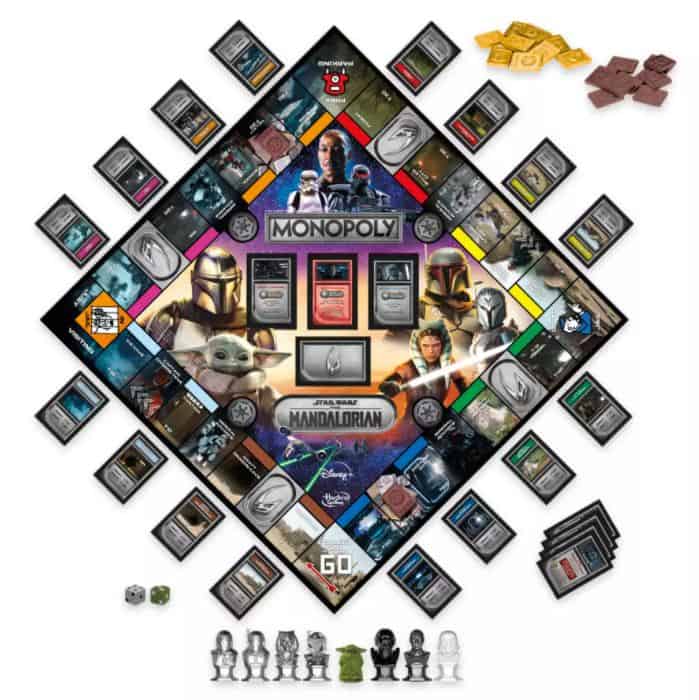
There are two dice in The Mandalorian Monopoly, but it works differently. If you don’t have the Child with you (don’t worry, I’ll explain that in a moment!), roll the silver die. If you do, roll the green die. As usual, you then move your token that many spaces clockwise around the board. As per standard Monopoly rules, if you land on an unowned hideout, you must either buy it or auction it. If you choose to purchase it (or win the auction), the hideout card should be placed in front of you. It details the rent charges. You should pay the rent as the card states if you land on a hideout already owned by someone else. You can trade hideouts, Signet cards, and credits at any time in the usual manner. You can’t, however, trade the Child.
If you can’t afford the rent, you can sell your hideouts back to the Bank for the same amount you bought them for (very generous). Alternatively, you could sell them to another player for however much you agree upon. If you still don’t have enough funds, hand over any unused Signet cards you have. You can’t go Bankrupt in this version.
Passing Go provides each player with 20 credits (2x bronze). Signet cards are basically Chance and Community Chest rolled into one, but they’re a bit more helpful and substantially more assertive.
There are also two Hyperspace Jump spots. These force you to jump to the nearest unowned hideout to either buy or auction it. If all the hideouts have been purchased, you move to the other Hyperspace Jump square and end your turn. If you pass Go, you collect your 20 credits. Otherwise, you can ignore all other tokens and cards unless you land on them.
If you land on or pass the square with the Child, he tags along with you. You then take the Child’s character card and place it in front of you. If another player lands on the same square or passes you, they take on the Child’s responsibility, taking his character card from you too. Anyone landing on Free Parking immediately steals the Child from wherever they are and whoever they’re with. Should you land on Go To Jail with the Child, you should place him on any hideouts you own (or leave him behind if you don’t own any). He can’t join you in Jail.
The “In Jail” rules are similar, too. Leaving Jail costs 50 credits (a substantial amount in this game). Alternatively, rolling a 6 means you’ll escape and move that many spaces. If, after three rolls, you haven’t rolled are 6, you are released for free and go straight to Just Visiting.
The places you’d usually find Railroads are Imperial Advance squares. If you land on one of these, you should leave your token where it is and roll the silver die again. Remove the Incinerator Stormtrooper and Death Trooper from their outpost and move them clockwise around the board that many spaces. They don’t take any actions based on the squares they land on. The Moff Gideon token is released when all the hideouts have been purchased, or only one Incinerator Stormtrooper or Death Trooper card remains.
On your turn, if you land on or pass one of the enemies, you must stop moving and battle them (which I’ll explain momentarily). If the enemy token passes you, nothing happens – whether or not you have the Child. However, if an enemy passes the Child while he’s unaccompanied, the game is over. Everyone loses.
Battling
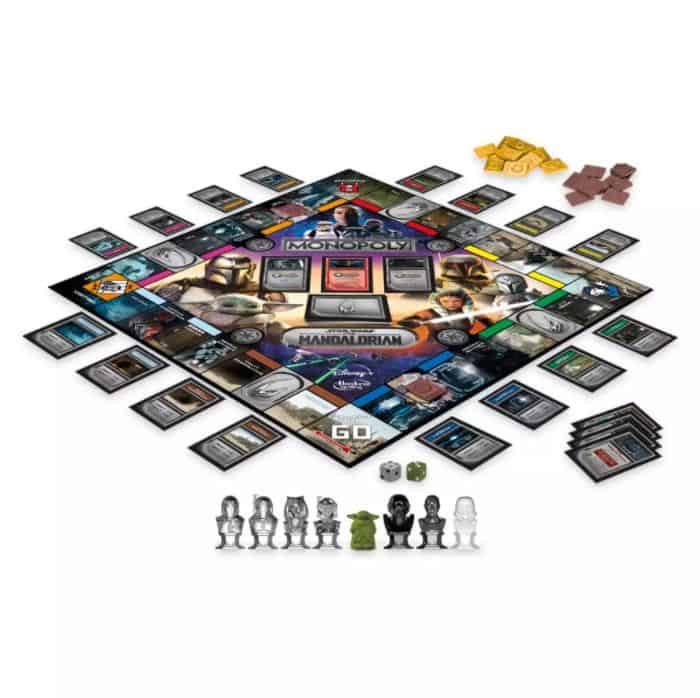
Take the top enemy card of the token you’ve passed from the center of the board. This card details the number you’ll need to roll to “win”. Use the silver die. If you have the Child with you, you can use the green die too.
Follow the instructions on the card depending on whether you win or lose. If you defeat them, take the enemy card and place it in front of you.
If enemy cards remain after your battle, advance the token to the next unoccupied Imperial Outpost. If no cards remain for that token, remove it from the board.
You’ll be fine as long as you don’t lose to Moff Gideon while you have the Child. If this happens, the Child is captured, and the game is over. Again, everyone loses.
The End of the Game
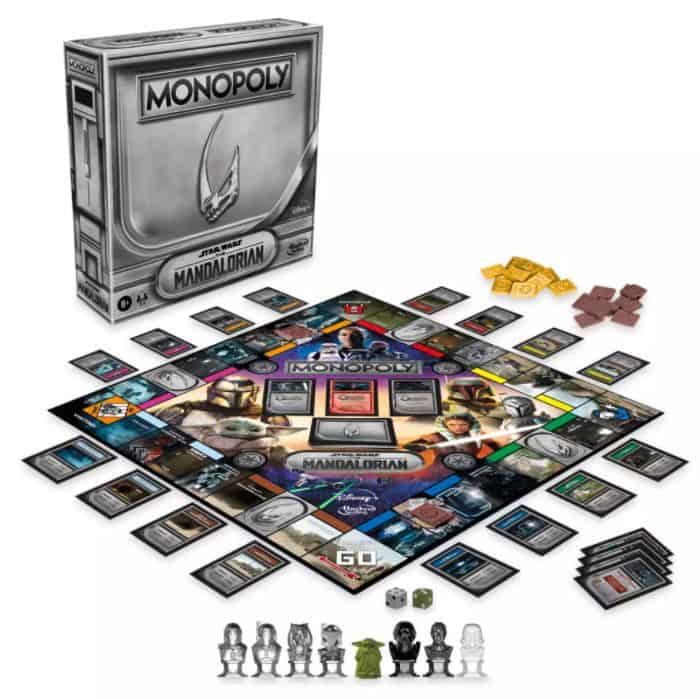
As I mentioned, you can’t go Bankrupt in The Mandalorian Monopoly. All players should still be playing by the end. The game finishes when Moff Gideon is defeated (or when the Child is captured).
At this point, the player to defeat him collects the 100-credit reward, and all turns cease. All players then receive the following:
- Everyone then takes one rent payment from the Bank for each hideout.
- The player with the Child receives 100 credits from the Bank.
- The player with the most enemy cards gets 50 credits from the Bank. In the case of a tie, the player with the most hideouts takes the money.
Everyone then totals up their credits. Whoever has the most wins.
Overall
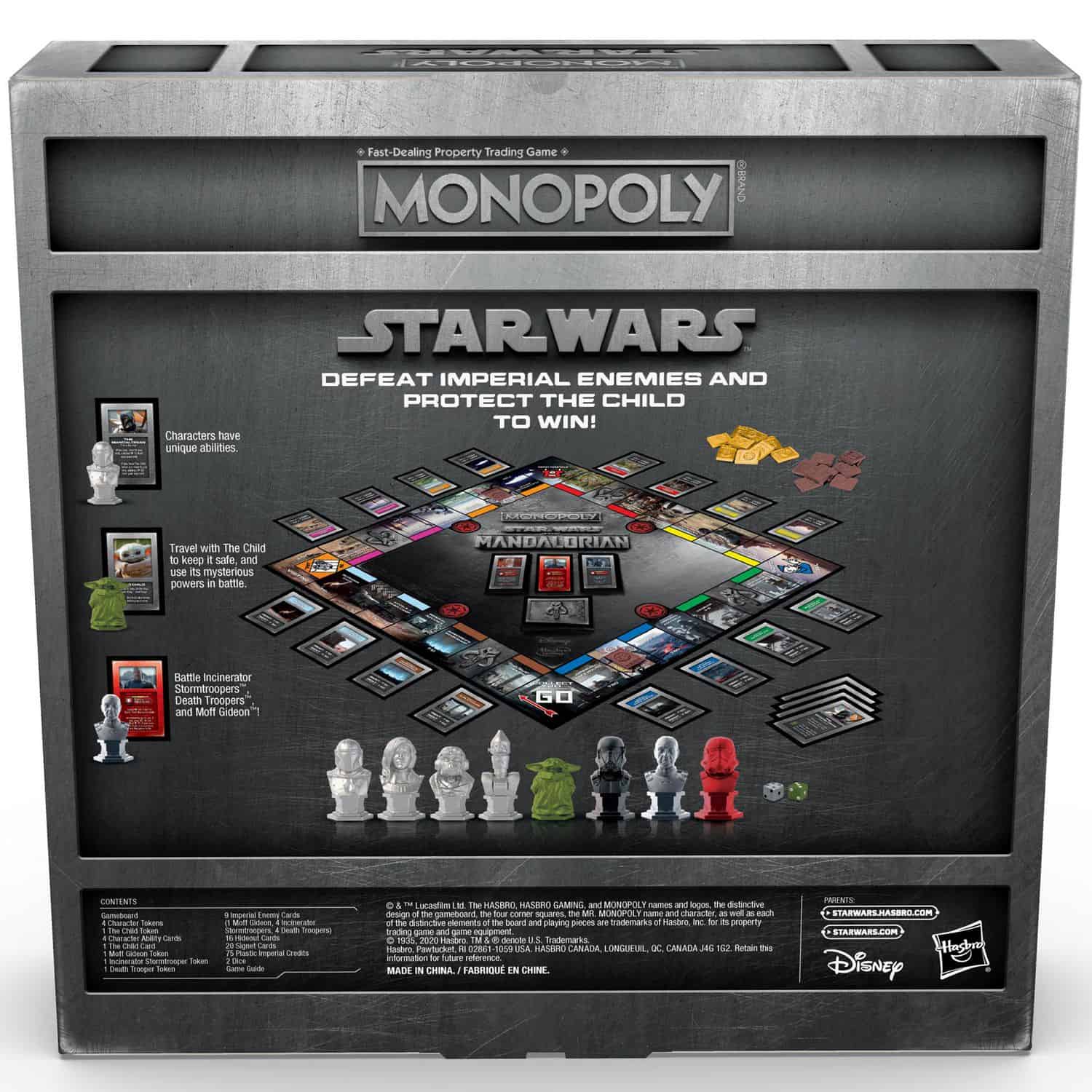
This is a family-friendly version of Monopoly, for sure, but I think that’s what’s needed sometimes. It encourages cooperation even though everyone’s still aiming to win. This (hopefully) should therefore help decrease the number of family arguments arising from Monopoly games. Basically, it’s better. I’d especially recommend it for avoiding temper tantrums (I’m looking more at the adults than the kids, here!) and just adding a bit of a spark to the slightly overdone Monopoly rules.
It’s available from Amazon and Walmart through these links.
Monopoly Star Wars (2015)
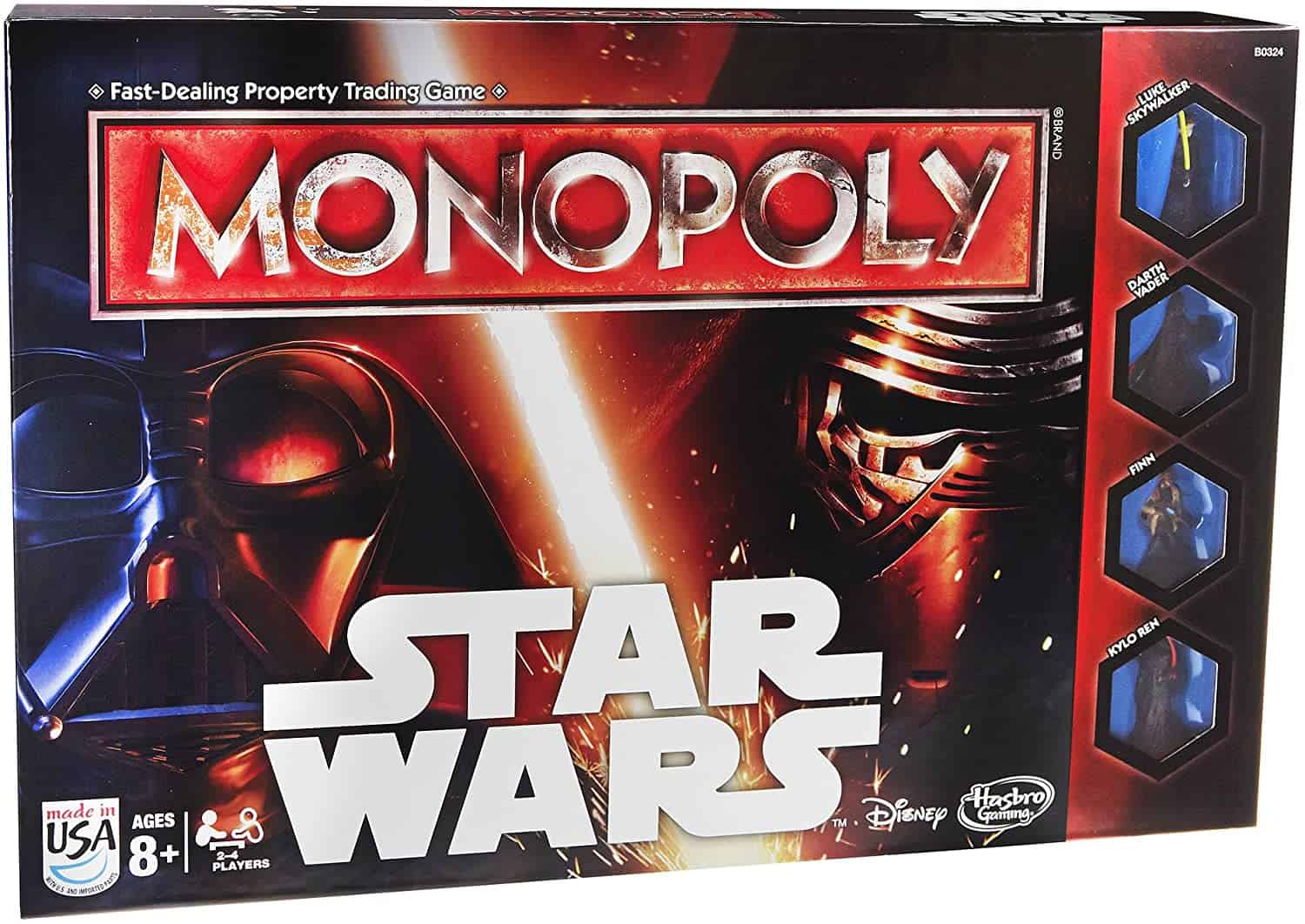
In this circular, galaxy-shaped edition of Monopoly for up to four players, you’ll work in teams. Finn and Luke Skywalker face off against Kylo Ren and Darth Vader. The object of the game is to have as many bases under your control as possible by the time the last one is bought.
Select your team and character, place them on Go, and then take one of the base token cards (these help with knowing who’s paying rent when you’re in teams). Each player starts with 1,500 credits.
Base tokens correspond to each character. Blue tokens relate to the Light Side, while red ones, of course, represent the Dark Side bases.
Instead of claiming a property when you land on it, you’ll place your base token on the corresponding area of the planet. The board shows you where to set it, don’t worry. It also shows you how much rent someone landing on it will pay. There are no deeds cards in this version. As per standard Monopoly, the rent gets doubled if you own the entire set. If the other member of your team lands on your base, the rent gets halved.
Landing on the red Star Destroyer or blue Millenium Falcon means drawing from the respective decks (like Community Chest and Chance). Light Side players start with three Millenium Falcon cards; Dark Side players begin with three Star Destroyer cards. These have are particularly influential on the game, so use them wisely and at the right time. Each card has two effects: one for the Light Side players and one for the Dark. Landing on your respective allegiance card yields a more powerful impact. You can also save the card for later, whereas landing on the opposite Side means using the effect immediately.
Hyperdrive spaces mean jumping to the next hyperdrive (although you won’t collect any credits for passing Go). The Bounty Hunter spot is an excellent space to land on. You can either take over an unowned base on the board or remove an enemy base and replace it with one of your own. The rules around Jail and passing Go are the same as standard Monopoly.
You can’t go Bankrupt. If you can’t pay the Bank, you remove your highest value base. If you owe another player, you’ll give them your highest value base. If you don’t have anything, you get let off for free. Nice.
The game finishes when all the base spots have been filled with tokens. Whichever team has the most bases wins.
Overall
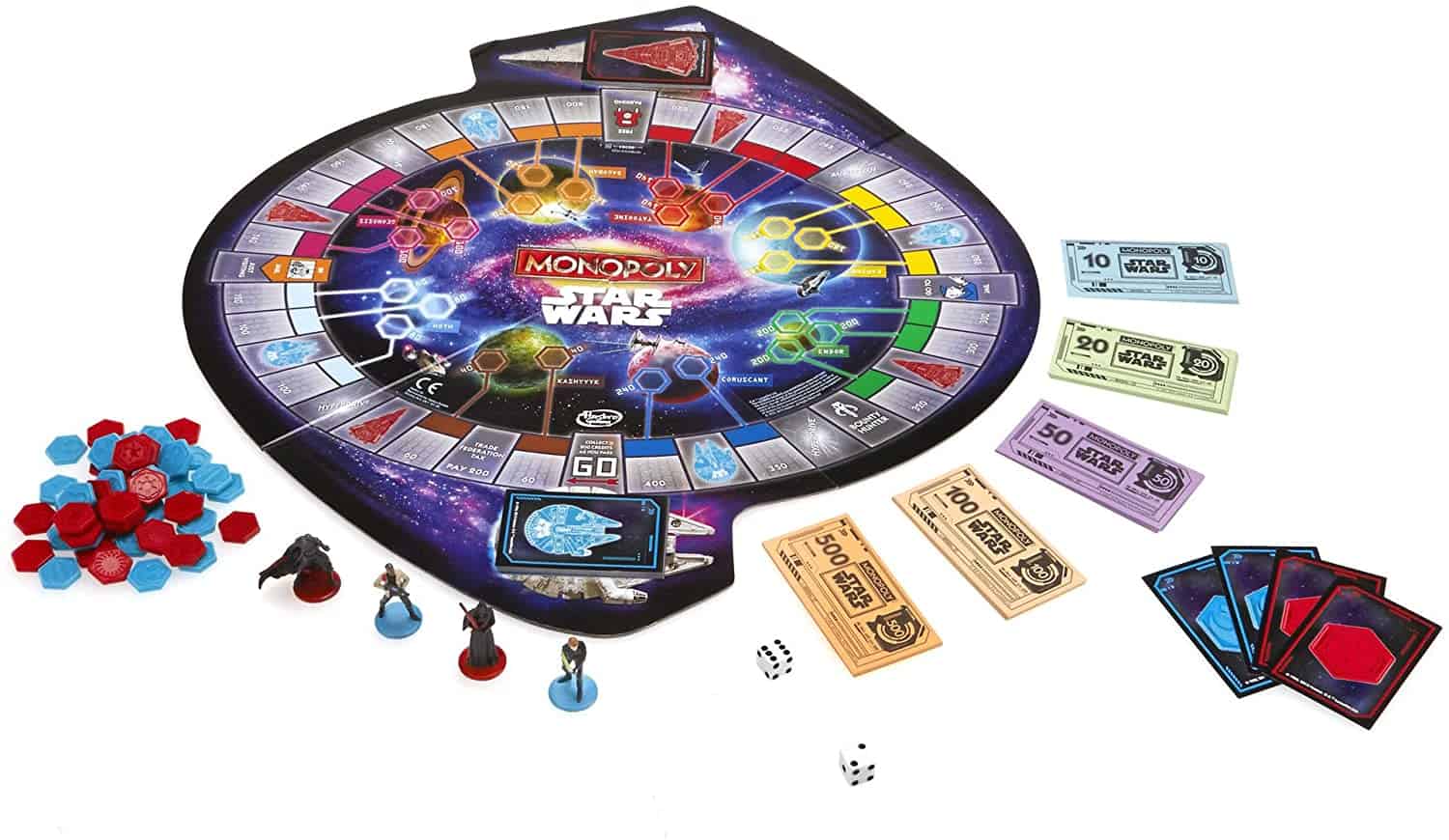
This is another decent twist to Monopoly. The game has a set end-point – something the standard game is undoubtedly missing. It also encourages teamwork, and by removing the deeds cards, there’s a bit less going on. I’d recommend it for casual gamers looking for a light-hearted evening in.
You can find it on Amazon here.
Conclusion
Monopoly isn’t for everyone, but Star Wars-themed Monopoly can make it slightly more interesting. Personally, I love the idea of a Monopoly game having a definitive point at which it ends. That would be my main general gripe with it. Although I’m a big Star Wars fan, my favorite thing about the games listed on this page is the different rules they introduce. In my opinion, they all function to make Monopoly – Star Wars or not – a more enjoyable and less frustrating game.
I hope this article has been interesting for you as you look for a Star Wars Monopoly set! At the very least, I hope it’s given you an idea of what you like and what you don’t. All the best with finding your ideal set!

FAQs
Question: What is a hideaway in Star Wars Monopoly?
Answer: In The Child Monopoly (a variation I haven’t listed here), hideaways replaced the Utilities. They have precisely the same effect as the Gas and Electricity Companies in the original game. Owning one means a rent of 4x the dice result; owning two is a rent of 10x the dice total.
Question: How do you get out of Jail in Star Wars Monopoly?
Answer: In most variations of Star Wars Monopoly, the rules are the same as the base version. You get three attempts to roll a double. If you roll a double, you leave Jail and move that many spaces immediately. Otherwise, you can pay to get out (usually 50 credits).
In The Mandalorian Monopoly, when you’ll only be using one die, you must roll a 6 to get out. This is actually the same probability as rolling a double with two dice.
Question: How much money does each player get in Star Wars Monopoly?
Answer: In standard Star Wars Monopoly sets (such as the Star Wars Saga Edition), each player gets 1,500 credits. This corresponds to the $1,500 you generally get in most standard Monopoly games. Two 500s, 100s, and 50s; six 20s; five 10s, 5s, and 1s.
- Terraforming Mars Guide: Fighting for Spaces in Space - April 22, 2023
- Zathura Board Game Guide - April 20, 2023
- Ark Nova Guide – Zoo Complex, Or Complex Zoo? - April 8, 2023

